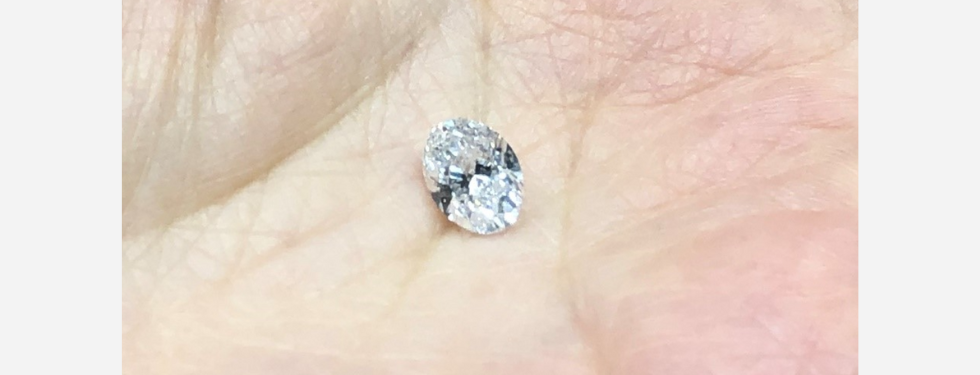A Super Deep Diamond sheds new light on earth's mantle boundary at 660 km

An international study, recently published in Nature Geoscience, analyzed a multi-phase inclusion within a super-deep diamond (Fig.1), and discovered the presence of ringwoodite, ferropericlase, and enstatite. This is the first report of such an association in one single inclusion and its presence confirms what geologists expected from laboratory experiments aimed at understanding the mineralogical composition and structure of the deepest and inaccessible regions of the Earth: this diamond comes from the incredible depth of 660 km, the so called boundary between the Earth’s transition zone and the lower mantle.
Scientists have long sought to investigate the chemical composition and mineralogy at great depths inside the Earth, but the impossibility of drilling often thousands of kilometers, is an obstacle that has so far proved insurmountable. In order to understand what lies beneath our feet and how the Earth behaves at great depths, scientists instead conduct lab experiments producing synthetic minerals under conditions of high temperature and pressure to simulate the conditions present in the deepest levels of the Earth. However, this approach cannot take into consideration the transformations that have occurred over millions of years and the interactions with the surroundings.
A way to go – virtually – where no one has gone before, is the study of diamonds and in particular of the inclusions trapped inside them. As chemically inert vessels, diamonds can envelop real fragments of minerals and, amazingly, protect them from chemical modifications with their surroundings when they are brought to the Earth's surface. Super-deep diamonds, those coming from depths of at least 300 kilometers in the Earth's mantle (and are thought to form down to even 1000 kilometers), are even more precious witnesses because they can shine new light on the boundary between the upper andlower mantle, a crucial part of the interior of our planet.
The first turning point was in 2014 when a super-deep diamond first revealed the presence of ringwoodite, [(Mg, Fe)2SiO4] containing 1.4% water, a mineral never found before in a terrestrial rock. Ringwoodite derives from the transformation of olivine at high-pressure conditions. Olivine is the most abundant mineral in the upper mantle and soaks up water like a sponge. Therefore, the 2014 discovery suggested that the diamond containing that mineral came from about 525 to 660 km below the surface and also that at those depths there could be vast storage of water in the mantle.
Returning to 2022 a new study, published in Nature Geoscience, now adds a fundamental contribution toward understanding the secrets of the deep Earth. Everything started with a 1.5 ct gem-quality diamond in New York City which could have otherwise ended up in someone's engagement ring if Dr. Tingting Gu, a gemologist at the time from the Gemological Institute of America, hadn't noticed and analyzed a multi-phase inclusion under a microscope and using Raman spectroscopy.
To confirm the first identification of the minerals in the inclusion, the diamond was sent to the Department of Geosciences of the University of Padova (Italy) where Prof. Fabrizio Nestola and his research team carried out special X-ray diffraction analyses.
X-ray diffraction confirmed what was observed with Raman spectroscopy and ringwoodite was discovered for the first time coexisting with ferropericlase [(Mg,Fe)O] and enstatite [(Mg,Fe)SiO3]. Enstatite is supposed to be regressed bridgmanite, the most abundant mineral in Earth. The ringwoodite-ferropericlase-enstatite association in this diamond can be formed on the actual boundary between the transition zone and lower mantle at 660 km depth because below 660 kilometers ringwoodite is no longer a stable mineral and it turns into bridgmanite and ferropericlase. Thus, the diamond studied in this publication provides a direct picture of one of the most mysterious and crucial regions of our Planet.
This work also had a crucial scientific contribution from Frank Brenker (University of Frankfurt), Matteo Alvaro (University of Pavia), Wuyi Wang (GIA), and John Fournelle (University of Wisconsin, Madison).

Figure 1. The super-deep diamond of 1.5 carats studied in the Gu et al. (2022) work
Article title: Hydrous peridotitic fragments of Earth’s mantle 660 km discontinuity sampled by a diamond
Authors: Tingting Gu, Martha G. Pamato, Davide Novella, Matteo Alvaro, John Fournelle, Frank E. Brenker, Wuyi Wang, Fabrizio Nestola
DOI: 10.1038/s41561-022-01024-y
LINK: https://www.nature.com/articles/s41561-022-01024-y
Further information can be requested from the corresponding authors of the study: Tingting Gu (gtt.pku@gmail.com) and Fabrizio Nestola (fabrizio.nestola@unipd.it)





